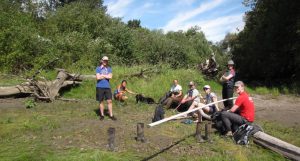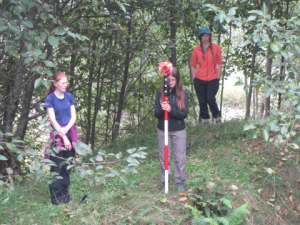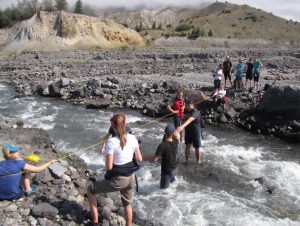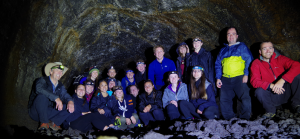
October 1, 2019, by lzzeb
The 2019 Mount St Helens field course – a staff perspective
A blog by Stephen Dugdale
In early September 2019, 15 students from the School of Geography, accompanied by Prof Colin Thorne, Dr Steve Dugdale, Dr Liam Clark and PhD candidate Hazel Wilson, travelled to the US state of Washington to learn about the ongoing impacts of the eruption of Mount St Helens. Now in its 4th year, the annual Mount St Helens field course gives students first-hand experience of how rivers in the region are being managed and restored following the catastrophic volcanic eruption in 1980. Although most people know about the eruption on May 18th 1980 and are familiar with its environmental and human cost, few realise that the impacts of the volcano continue to cause problems for rivers in the region and the ecosystems and communities that depend upon them.
Aside from the initial volcanic blast, which flattened over ~600 km2 of forest and rained 540 million tons of ash on an area of ~57,000 km2, the volcano unleashed a series of immense mudflows (known as ‘lahars’) which destroyed settlements along the Toutle River, burying its upper valley to as much as 180 m deep. Even almost 40 years after the eruption itself, this sediment continues to creep slowly downriver, threatening the downstream cities of Castle Rock and Longview and impacting the sensitive ecology of the river systems in the area. For the past 4 years, students from the University of Nottingham have helped contribute to monitoring this problem by documenting how the North Fork Toutle River channel shifts from year to year. The data the students collect is therefore instrumental in understanding how the river continues to evolve since the eruption.
After an initial orientation day taking in views of Mount St Helens from the Johnston Ridge Observatory, the students were given a crash course in how to use a total station (a laser measurement tool capable of measuring distances and elevations with an extremely high degree of precision). The next three days of the field course were spent using this instrument to obtain highly accurate cross sections of the North Fork Toutle River. Kitted out in river shoes and carrying the survey gear on their backs, the students braved angry wasps, surging white water, baking sunshine and freezing fog to trek upstream to their allotted survey locations. Despite never having used a total station before, the newly fledged surveyors did a brilliant job, successfully collecting 7 highly-detailed river cross sections that will provide the United States Geological Survey with crucial information on how the North Fork Toutle River has changed over the last year.
After completing the survey work, the next couple of days were spent a bit closer to our ‘home away from home’, the Mount St Helens Eco Park Resort. Here, the students spent time undertaking annual condition assessments of a series of artificial logjams installed in the river to slow the movement of sediment downstream. Despite the pouring rain, the students completed these surveys in record time, giving them the opportunity to start working on their video diaries (their first assignment for the module) in the comfort of the Eco Park.

Assessing the condition of artificial logjams built to stop sediment movement (Photos: Colin Thorne, Steve Dugdale)
After seven fascinating days on the slopes of Mount St Helens, it was time to say goodbye to the mountain and shift our fieldwork base to the city of Woodland, Washington. However, no trip to Mount St Helens is complete without a tour of Ape Cave, a stunning lava tube buried deep under the mountain, and the students took a well-deserved break from fieldwork by exploring this 4 km long volcanic phenomenon. As staff, we were really pleased to see the teamwork and sense of adventure displayed by the students, as they helped each other scramble over boulders and scale a 2 m high sheer rock face on the way back up to fresh air.
The final three days of the field course gave the students direct exposure to an ongoing river restoration project (Wapato Valley Mitigation and Conservation Bank). Here, areas of wetland that were previously drained for farmland are being restored to their former glory to improve habitats for a range of sensitive fish and aquatic species. The students used their newfound surveying skills to map out a blocked channel that is due to be re-opened in 2020, generating critical baseline information that will be used to help understand the success of the restoration project. They also contributed to ongoing monitoring of wood in another stream on the site, important data given the crucial role of in-stream wood in the establishment and maintenance of aquatic habitats. These long, hot days in the field were rewarded with a trip to the beach complete with southern-style beach BBQ – everyone (staff included!) was happy to take a dip in the cool Lewis River and enjoy a few rounds of beach softball.

Taking a break from monitoring large wood at the Wapato Valley Mitigation and Conservation Bank (Photo: Colin Thorne)
Sadly, all great things must come to an end, and after 12 amazing days exploring the Pacific Northwest USA, it was time to come home. After a quick daytrip to Portland, Oregon, for some last minute shopping and souvenir hunting, we arrived at the airport. Although tired and looking forward to being back in the UK, we left with memories and experiences that will last a lifetime. I can only speak for my experience as a member of staff on the trip, but I had a great time. I was hugely impressed by how well our students got stuck into the fieldwork, and their ‘work-hard, play-hard’ attitude gave the field course the perfect atmosphere. For the students, this may be the start of a love of travelling to the Pacific Northwest or further afield…and as for the staff, we can’t wait to help out again with next years’ trip!
No comments yet, fill out a comment to be the first




Leave a Reply